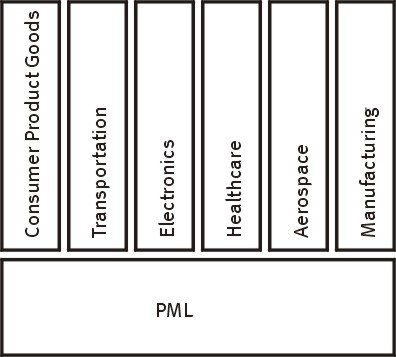Introduction
The
Physical Markup Language (PML) is proposed as a general,
standard means for describing physical objects and environments
for industrial, commercial and consumer applications.
Given the broad scope of this vision, PML is crafted
to allow modularity and flexibility.
The objective of PML is a simple, general language for
describing physical objects for use in monitoring and
control of a physical environment - particularly through
the Internet. Applications include inventory tracking,
automatic transaction, supply chain management, machine
control and object-to-object communication.
Our approach has been to develop a set of standard components
that span the breadth of application together with an
extension mechanism allowing customization within vertical
industries, as illustrated in Figure 1.
 |
Figure
1. PML is comprised of a basis set of components
that describes elements common to most industries
and a data dictionary system allowing customization
within vertical industries. |
Since
standard PML components are common across industry,
they must, by definition, be basic, modular and elemental.
These basic description, therefore, must be common to
nearly every physical object. For example, objects are
composed of matter. They have physical properties -
volume and mass. They exist is certain forms (solid,
liquid and gas) and have measurable states (temperature,
pressure and weight).
Man-made objects exhibit structure. Many have a hierarchical
form of system, assembly, subassembly and component.
Objects exist in time and place. Their exact movement
and location are critical for commerce and industry.
Products have attributed values of worth, cost and price
- and nearly every object is owned by somebody.
These attributes, we argue, are common to every physical
object, independent of particular industry. We should
not, therefore, recreate identical definitions within
different industries, but rather encourage the adoption
of a common standard.
In the PML Specification, we propose standard definitions
for these common characteristics. These definitions
include time, place, measurement, configuration, geometry,
physical properties, classification, presentation and
history. We will also introduce a mechanism to allow
customization and extension within industry groups.
Together these language elements will allow users to
share common data about physical objects within and
across industries and applications.
|

